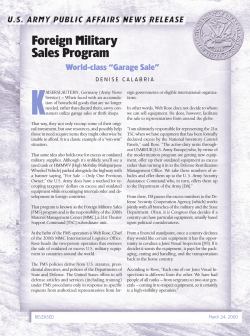
Irrational Expectations
Sinology a We need to accept and understand that the necessary restructuring and rebalancing of China’s economy does mean that almost every aspect of the economy will continue to grow at a gradually slower year-on-year pace for the foreseeable future. a Party leaders do not appear to be too worried, and they have refrained from opening their wallets for a significant stimulus. a Investors should keep the slower growth rates in context. Many parts of the economy are clearly still doing well, with manufacturing wages rising 5% to 8%, income rising 8% and the number of new business registrations up 38% in 1Q. Understanding why China is slowing, and the long-term benefits of the restructuring policies that are contributing to that slowdown, is important to understanding China’s impact on the global economy, and on an investor’s portfolio. ANDY ROTHMAN lived and worked in China for more than 20 years, analyzing the country’s economic and political environment, before joining Matthews Asia in 2014. As Investment Strategist, he has a leading role in shaping and presenting the firm’s thoughts on how China should be viewed at the country, regional and global level. by Andy Rothman April 16, 2015 IRRATIONAL EXPECTATIONS Do we have irrational expectations for the Chinese economy? On the one hand, we asked China to restructure and rebalance its economy, and it has delivered. It shrunk its state sector, and privately owned firms now account for more than 80% of employment and almost all new job creation. Almost all prices are set by the market. Investment growth is slowing and consumption is now the engine of economic expansion. China’s service sector is now larger than its manufacturing and construction sectors. But at the same time, we are freaking out because a natural consequence of this restructuring is gradually slowing economic growth. How, we ask, can China survive with only 7% GDP growth? Let’s take a look at just how terrible China’s first quarter macroeconomic performance really was. The World’s Best Consumption Story A very weak industrial sector was balanced by strong consumption and service sector activity, fueled by healthy income growth. Inflation-adjusted (real) income rose by 8.1% year-on-year (YoY) during the first quarter, down slightly from 8.6% during the first quarter of 2014. Income for migrant workers, who move from the countryside to staff the nation’s factories and construction sites, rose 11.9%, up from 10.1% a year ago, reflecting a tight labor market. Strong wage growth and positive consumer sentiment led real retail sales to rise 10.8% in the first three months of the year, compared to growth rates of 10.9% last year as well as in 2013. In March, sales for cosmetics rose 10% and furniture sales were up 20%. In the first quarter, movie box office receipts hit a record US$1.5 billion, up almost 40% YoY. Online retail sales rose 41%. Figure 1. REAL GROWTH RATE OF RETAIL SALES Year-on-Year 16% 14% 12% 10% 8% 6% 4% 2% 0% Jan-10 Source: CEIC Sep-10 Jun-11 Mar-12 Dec-12 Sep-13 Jun-14 Mar-15 Industrial value-added output rose by only 6.4% in 1Q15, down from 8.7% a year earlier. But this was balanced by stronger growth in the valueadded production of the *tertiary sector—including services, wholesale and retail trade, as well as the financial sector and real estate, which rose 7.9%, marginally faster than a year ago. The tertiary part of the economy continues to be larger and contribute more to economic growth than the secondary part, which includes manufacturing and construction. Rebalancing at work. *Industries defined as: Primary industry refers to agriculture, forestry, animal husbandry and fishery and services in support of these industries Secondary industry refers to mining and quarrying, manufacturing, production and supply of electricity, water and gas, and construction Tertiary industry refers to all other economic activities not included in the primary or secondary industries, including real estate, finance, wholesale and retail, transportation and other service industries Figure 2. SERVICES MORE IMPORTANT THAN MANUFACTURING AND CONSTRUCTION Share of GDP 60% 50% 40% 30% 20% 10% 0% 1952 Primary industry 1960 1965 1970 Secondary industry 1975 1980 1985 1990 1995 2000 2005 2010 1Q15 Tertiary industry Source: CEIC Some parts of the economy have suffered more from these big structural shifts. Value-added output of the mining industry, for example, rose by only 1.4% last month, while the value-added of manufacturing of computer and telecom equipment rose 12.3%. As a result, industrial value-added fell 3.2% in the northeastern region, home to a large share of construction-related factories and resources extraction, while the rest of the country saw increases of 6% or more. Figure 3. 2014 GDP GROWTH RATE BY PROVINCE Below 7% 7–8% Above 8% Source: CEIC 2 Property Showing Signs of Stabilizing Even though the government only removed some barriers to new home purchases (reducing the minimum cash down payment to 40%, from 70%, for upgraders) at the end of last month, the residential market showed signs of stabilizing. New home sales fell only 0.9% YoY by volume, after declining 17.8% during the first two months of the year. It is also positive that developers have been responding to weaker sales and mounting inventory by cutting housing starts 20% YoY. As we’ve explained in past issues of Sinology, China’s housing market is past its peak and is very soft, but we believe a collapse is highly unlikely. Trade Softer, but Also Far From Collapse You’ve probably read dire headlines about weak China trade numbers for March, but the story is more nuanced. China’s exports fell 15% YoY in U.S. dollar terms last month, compared to an increase of 48.3% in February. But the huge difference is explained largely by the lunar New Year effect and monthly volatility. There is no evidence of collapse in China’s main export markets, nor is there reason to believe that China’s exports suddenly became far less competitive. If we look at the first three months of the year, to smooth out the holiday effect, exports rose by 4.7%, compared to a decline of 3.4% during 1Q14. In 1Q this year, exports of machinery and electronics products, which account for 58% of total exports, rose 6.4% YoY. In 1Q15, exports to the E.U. in U.S. dollar terms rose by only 2.4%, down from 6% a year ago. Exports to Japan fell 11.8%, compared to a rise of 6.7% a year ago. But exports to the Association of Southeast Asian Nations (ASEAN) rose 20.6% (6.8% a year ago) and shipments to the U.S. rose 11.2%, up from 1.3% a year ago. Imports fell 17.6% during 1Q15, compared to an increase of 1.6% in 1Q14. But much of this was due to sharp falls in commodity prices. For example, during 1Q15, iron ore imports rose 2.4% by volume, and the average price was down 45%. Crude oil imports rose 7.5% by volume, while the average price was down 47%. Costs of Restructuring We need to accept and understand that the necessary restructuring and rebalancing of China’s economy— along with changes in demographics and the law of large numbers (two decades of 10% growth)—does mean that almost every aspect of the economy will continue to grow at a gradually slower YoY pace for the foreseeable future. (Be prepared for a steady diet of newspaper articles telling you that the latest quarter’s growth rate was the slowest since the Tang Dynasty!) We’d like to ask two questions about this state of affairs. First, how worried is the Communist Party about the gradual deceleration? Second, how worried should investors be? Party leaders do not appear particularly worried. They have refrained from opening their wallets for a significant stimulus: the growth rates of credit outstanding and of fiscal spending have continued to decelerate. The Party has, however, given a modest boost to infrastructure investment, which rose 22.3% in 1Q15, compared to 20.7% last year and 19.7% in 2013. In my view, this is designed to put a floor under growth by compensating for weak housing investment, but the Party shows no signs of wanting to reaccelerate GDP growth back beyond the first quarter’s 7% pace. 3 Figure 4. YEAR-ON-YEAR GDP GROWTH RATE 15% 10% 5% 0% Mar-00 Mar-01 Mar-02 Mar-03 Mar-04 Mar-05 Mar-06 Mar-07 Mar-08 Mar-09 Mar-10 Mar-11 Mar-12 Mar-13 Mar-14 Mar-15 Quarterly GDP Annual GDP Source: CEIC Investors should keep the slower growth rates in context. GDP growth of 7% is significantly slower than 10%, but because of the larger base, that 7% will deliver far larger incremental expansion of the economy than 10% a decade ago, meaning greater opportunity for investors. And, 7% is still 7%! U.S. GDP rose 2.4% last year. Many parts of the economy are clearly still doing well. While traveling in China last week, I heard from small private manufacturers who told me they were planning to raise wages by 5% to 8% this year. Income growth of 8% compares favorably to 3.2% growth in the U.S., as does Chinese retail sales growth of 10.8% vs. 3% in the U.S. The number of new business registrations in China rose 38% in 1Q. Understanding why China is slowing, and the long-term benefits of the restructuring policies that are contributing to that slowdown, is important to understanding China’s impact on the global economy, and on an investor’s portfolio. The views and information discussed in this report are as of the date of publication, are subject to change and may not reflect the writer’s current views. The views expressed represent an assessment of market conditions at a specific point in time, are opinions only and should not be relied upon as investment advice regarding a particular investment or markets in general. Andy Rothman Investment Strategist Matthews Asia The subject matter contained herein has been derived from several sources believed to be reliable and accurate at the time of compilation. Matthews International Capital Management, LLC does not accept any liability for losses either direct or consequential caused by the use of this information. ©2015 Matthews International Capital Management, LLC SI015 4
© Copyright 2025









